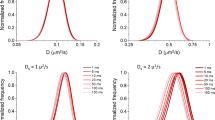Summary
The dissociation constant for actin binding to myosin and its subfragments (S1 & HMM) is ≪ 1 μm at physiological ionic strength. Many of the methods used to measure such affinities are unreliable for a Kd below 0.1 μm. We show here that the use of phalloidin to stablise F-actin and fluorescently labelled proteins allows the affinity of actin for myosin S1 to be measured in a simple transient kinetic assay. The method can be used for Kd's as low as 10 nm and we demonstrate that the Kd's can be estimated using only μg quantities of material. Furthermore we suggest how this method may be adapted for ng quantities of protein. This will allow the affinity of actin for myosin fragments to be estimated for proteins which are difficult to obtain in large quantities i.e. from biopsy material or from proteins expressed in baculovirus.
Similar content being viewed by others
References
AGUIRRER., GONSOULINF. & CHEUNGH. C. (1986) Interaction of fluorescently labeled myosin subfragment 1 with nucleotides and actin. Biochemistry 25, 6827–35.
COATESJ. H., CRIDDLEA. H. & GEEVESM. A. (1985) Pressure-relaxation studies of pyrene-labelled actin and myosin subfragment 1 from rabbit skeletal muscle. Biochem. J. 232, 351–6.
CONIBEAR, P. B. (1993) Solution Studies on the interactions between the two heads of heavy meromyosin and on the effect of ADP on the interaction of myosin subfragment 1 with actin. PhD thesis, Bristol.
COOKR. K., ROOTD., MILLERC., REISLERE. & RUBENSTEINP. A. (1993) Enhanced stimulation of myosin subfragment 1 ATPase activity by addition of negatively charged residues to the yeast actin NH2 terminus. J. Biol. Chem. 268, 2410–15.
CRIDDLEA. H., GEEVESM. A. & JEFFRIEST. (1985) The use of actin labelled with N-(1-pyrenyl)iodoacetamide to study the interaction of actin with myosin subfragments and troponin/tropomyosin. Biochem. J. 232, 343–9.
DANCKERP., LOWI., HASSELBACHW. & WIELANDT. (1975) Interaction of actin with phalloidin: polymerization and stabilization of F-actin. Biochim. Biophys. Acta 400, 407–14.
GEEVESM. A. & JEFFRIEST. E. (1988) The effect of nucleotide upon a specific isomerization of actomyosin subfragment 1. Biochem. J. 256, 41–6.
HIGHSMITHS., MENDELSONR. A. & MORALESM. F. (1976) Affinity of myosin S-1 for F-actin, measured by time-resolved fluorescence anisotropy. Proc. Natl Acad. Sci. USA 73, 133–7.
KONRADM. & GOODYR. S. (1982) Kinetic and thermodynamic properties of the ternary complex between F-actin, myosin subfragment 1 and adenosine 5′-[β, γ-imido]triphosphate. Eur. J. Biochem. 128, 547–55.
KOUYAMAT. & MIHASHIK. (1981) Fluorimetry study of N-(1-pyrenyl)iodoacetamide-labelled F-actin. Eur. J. Biochem. 114, 33–8.
KRONS. J. & SPUDICHJ. A. (1986) Fluorescent actin filaments move on myosin fixed to a glass surface. Biochemistry 83, 6272–6.
LEHRERS. S. & KERWARG. (1972) Intrinsic fluorescence of actin. Biochemistry 11, 1211–17.
MANSTEIND. J. & HUNTD. M. (1995) Overexpression of myosin motor domains in Dictyostelium: screening of transformants and purification of the affinity tagged protein. J. Muscle Res. Cell Motil. 16, 325–32.
MANSTEIND. J., RUPPELK. M. & SPUDICHJ. A. (1989) Expression and characterization of a functional myosin headfragment in Dictyostelium discoideum. Science 246, 656–8.
MARGOSSIANS. S. & LOWEYS. (1978) Interaction of myosin subfragments with F-actin. Biochemistry 17, 5431–9.
MARSTONS. B. (1982). The rates of formation and dissociation of actin-myosin complexes. Biochem. J. 203, 453–60.
MARSTONS. & WEBERA. (1975) The dissociation constant of the actin-heavy meromyosin subfragment-1 complex. Biochemistry 14, 3868–73.
MILLERC. J. & REISLERE. (1995) Role of charged amino acid pairs in subdomain-1 of actin in interactions with myosin. Biochemistry 34, 2694–700.
PATOM. D., SELLERSJ. R., PRESTONY. A., HARVEYE. V. & ADELSTEINR. S. (1996) Baculovirus expression of chicken nonmuscle heavy meromyosin II-B. J. Biol. Chem. 271, 2689–95.
SPARROWJ., DRUMMONDD., PECKHAMM., HENNESSEYE. & WHITED. (1991) Protein engineering and the study of muscle contraction in Drosophila flight muscle. J. Cell Sci. 14, 73–8.
SUTOHK., ANDOM., SUTOHK. & TOYOSHIMAY. Y. (1991) Site-directed mutations of Dictyostelium actin: disruption of a negative charge cluster at the N terminus. Proc. Natl Acad. Sci. USA 88, 7711–14.
SWEENEYH. L., STRACESKIA. J., LEINWANDL. A., TIKUNOVB. A. & FAUSTL. (1994) Heterologous expression of a cardiomyopathic myosin that is detective in its actin interaction. J. Biol. Chem. 269, 1603–5.
TRYBUSK. M. (1994) Regulation of expressed truncated smooth muscle myosins. J. Biol. Chem. 269, 20819–22.
WEEDSA. G. & TAYLORR. S. (1975) Separation of subfragment-1 isoenzymes from rabbit skeletal muscle myosin. Nature 257, 54–7.
WESTJ. J., NAGYB. & GERGELEYJ. (1967) The effect of EDTA on spectral properties of ATP-, ADP-, and ITP-G-actin. Biochem. Biophys. Res. Commun. 29, 611–29.
WHITEH. D. & TAYLORE. W. (1976) Energetics and mechanism of actomyosin adenosine triphosphatase. Biochemistry 15, 5818–26.
Author information
Authors and Affiliations
Rights and permissions
About this article
Cite this article
Kurzawa, S.E., Geeves, M.A. A novel stopped-flow method for measuring the affinity of actin for myosin head fragments using μg quantities of protein. J Muscle Res Cell Motil 17, 669–676 (1996). https://doi.org/10.1007/BF00154061
Received:
Revised:
Accepted:
Issue Date:
DOI: https://doi.org/10.1007/BF00154061




